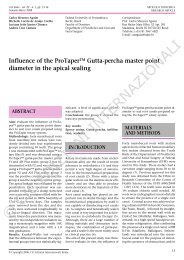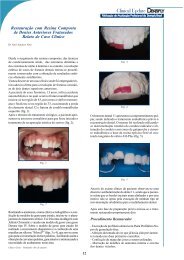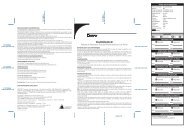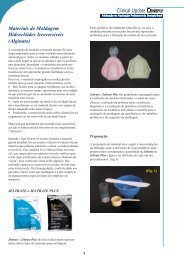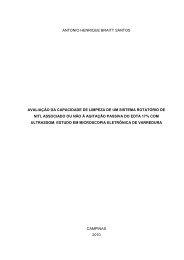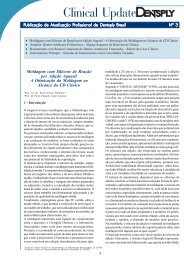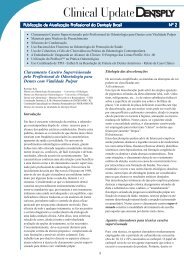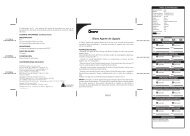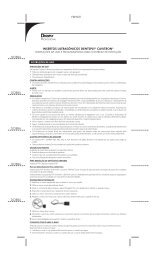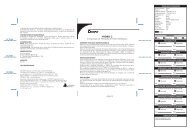Create successful ePaper yourself
Turn your PDF publications into a flip-book with our unique Google optimized e-Paper software.
XP BOND in Self-curing Mode used for Luting Porcelain<br />
Restorations. Part A: Microtensile Test<br />
Ornella Raffaelli a /Maria Crysanti Cagidiaco b /Cecilia Goracci c /Marco Ferrari d<br />
Purpose: To assess the bond strength to dentin of an experimental adhesive and the proprietary resin cement used<br />
in different curing modes to lute ceramic disks of different thicknesses.<br />
Materials and Methods: Empress II disks (Ivoclar-Vivadent) were luted to dentin using XP BOND (<strong>Dentsply</strong> [XP]) in<br />
combination with the proprietary self-curing activator (SCA) and cement Calibra (<strong>Dentsply</strong> [C]). Curing of the adhesive<br />
was induced either by mixing with the activator (activator, groups 3 to 6) or by light irradiation for 20 s (group 2). The<br />
cement was either light cured for 40 s through the ceramic onlay (groups 1 to 5) or cured chemically (groups 6 and 7).<br />
Groups 2 and 4 were compared with group 1, in which Prime & Bond NT (<strong>Dentsply</strong> DeTrey) was tested as control. In<br />
groups 3 and 6, 2-mm-thick onlays were luted with XP+SCA, and the cement was light cured for 40 s or let autocure for<br />
5 min, respectively. These groups were compared with group 7, in which Syntac (Ivoclar Vivadent) was applied with C<br />
and, in order to reproduce the handling procedures of group 6 (although contrary to manufacturer’s instructions), no<br />
light irradiation was provided for the adhesive or the cement. The influence of onlay thickness (2, 3, 4 mm) on the<br />
bond strength developed by XP+SCA/C was assessed by comparing groups 3, 4, 5. In these groups, C was light cured<br />
for 40 s through the onlay. Microtensile beams were obtained from the luted teeth.<br />
Results: Bond strengths not including pretest failures (in parentheses: value including pretest failures as 0 MPa) were<br />
21.0 (17.5) MPa in group 1, 24.9 (21.2) MPa in group 2, 23.7 (21.3) MPa in group 3, 29.9 (26.7) MPa in group 4, 30.3<br />
(24.6) MPa in group 5, 28.6 (24.6) MPa in group 6, and 17.1 (9.2) MPa in group 7. Statistically significant differences<br />
were found between groups 1 and 4, groups 3 and 5, and groups 6 and 7.<br />
Conclusion: The bonding potential of XP BOND used with the activator or light cured in combination with Calibra in<br />
self- or dual-curing mode outperformed that of a control adhesive-cement system. The bond strength of XP+ SCA + Calibra<br />
was not negatively affected by the onlay thickness.<br />
J Adhes Dent 2007; 9: 275-278. Submitted for publication: 15.12.06; accepted for publication: 5.1.07.<br />
a PhD Student, Department of Dental Materials and Prosthodontics, University of<br />
Siena, Siena, Italy.<br />
b Clinical Professor of Dentistry, Department of Dental Materials and Prosthodontics,<br />
University of Siena, Siena, Italy.<br />
c Assistant Professor and Chair, Department of Endodontics, University of Siena,<br />
Siena, Italy.<br />
d Professor and Chair, Department of Dental Materials and Prosthodontics, University<br />
of Siena, Siena, Italy.<br />
Paper presented at Satellite Symposium on Dental Adhesives, Dublin,<br />
September 13th, 2006.<br />
Reprint requests: Prof. Marco Ferrari, Research Center for Dental Health, 19 Piazza<br />
Attias, 57120 Livorno, Italy. Tel: +39-586-892-283, Fax: +39-586-898-305.<br />
e-mail: ferrarimar@unisi.it<br />
Many new bonding systems are introduced every year on<br />
the market. Some of them are primer-adhesive solutions<br />
in combination with a prior phosphoric acid treatment,<br />
others avoid the total-etch step and offer self-etching or selfadhesive<br />
bonding solutions. 3,5,7-10<br />
However, practitioners would like to use the same bonding<br />
systems for all clinical applications, although most simplified<br />
bonding solutions are not necessarily indicated for<br />
luting indirect restorations, limiting their clinical indications<br />
to direct restorations.<br />
Recently, XP BOND (<strong>Dentsply</strong> DeTrey; Konstanz, Germany),<br />
using tert-butanol for the first time as solvent in dentistry,<br />
was proposed as a one-bottle universal adhesive, also<br />
in combination with a new self-curing activator (SCA).<br />
When luting a porcelain restoration, differences in thickness<br />
may reduce the light penetration, resulting in a reduced<br />
polymerization rate of the luting material. 1,2,4 To avoid<br />
an incomplete cure of the resin cement adhesive interface,<br />
the self-curing activator can be used.<br />
Consequently, the aims of this study were to evaluate (1)<br />
the procedure for adhesively luting ceramic to dentin and,<br />
specifically, when light is applied, to cure either the adhesive<br />
before or after applying the cement, (2) the influence of ceramic<br />
thickness when the adhesive is not separately light<br />
cured but mixed with a self-curing activator (SCA), (3) the influence<br />
of SCA on the bonding efficacy when no light is<br />
used. The null hypothesis tested is that differences in porcelain<br />
thickness and curing mode do not affect the bond<br />
strength values.<br />
Vol 9, Supplement 2, 2007 275



